SC&RA jobs of the year: champions of road and rigging
20 August 2019
The 2019 SC&RA Job of the Year winners were announced at the Specialized Carriers & Rigging Association Annual Conference in California, USA. Mike Chalmers, Tim Hillegonds, D.Ann Shiffler, and Hannah Sundermeyer report
Rigging over US$2 million: Barnhart
Piecing it together
Barnhart Crane & Rigging assembled one of the world’s largest presses
In February 2018 Barnhart Crane & Rigging completed a project whereby they received 37 press components from the Port of Long Beach, California, USA, ranging from 250,000 to 732,000 pounds (113 to 332 tonnes), transported them to the site and assembled the largest hydraulic forging press in North America.
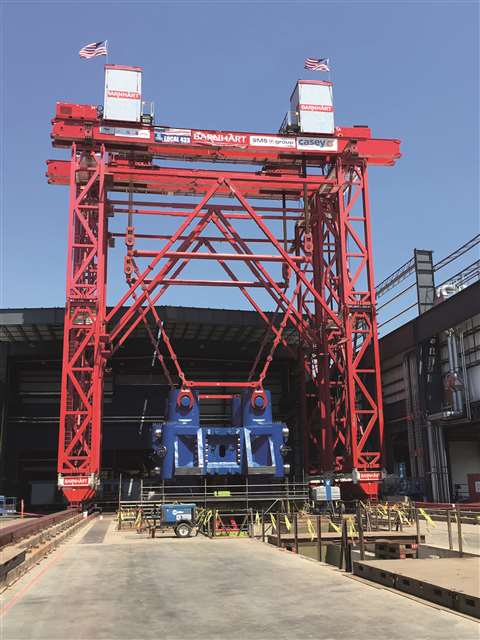
Barnhart’s press assembly project comprised 3,500 engineering hours and over a year of planning
“We were contracted to unload the equipment, move the pieces into the building, assemble the pieces into the larger components and then set the equipment to the foundation,” said Barnhart branch manager Chris Howe.
To assemble the press, Barnhart needed to upend and lift eight pieces around 700,000 pounds (318 tonnes), perform two lifts at just under 3,000,000 pounds (1,361 tonnes) and make one lift at 4,400,000 pounds (1,996 tonnes). Of note: the facility had a maximum ground bearing of 10,000 PSF.
“After our initial engineering, we realised that several improvements would need to be made,” Howe said. “The first challenge we had was ground bearing. To help spread the load, we started with a double layer of steel crane mats. We then designed and fabricated a custom load-spreading beam and tower sliding shoe, which would evenly spread the load over the entire base of the tower.”
The first major lift was the lower cross head, which, once assembled, was approximately 42 feet (12.8 m) wide, 14 feet (4.3 m) tall and weighed 2,500,000 pounds (1,134 tonnes).
“Fitting the pieces was a challenge, since they had to be within twenty thousandths of an inch alignment in order to install the tie rods,” Howe said.
Cylinders set
Piece by piece, Barnhart put together the various components. The lift tower was equipped with four strand jacks, and all the rigging was done using an adjustable rigging link system, which provided versatility and eliminated wire rope. Multiple pieces were shipped in the horizontal position and had to be assembled to make up the main hydraulic cylinder which, along with the piston, was eventually rotated 180 degrees so the piston could be installed downward. This lift was accomplished with the lift tower assisted by the gantry tailing the cylinder.
“Once the cylinders were in the correct orientation, we disconnected the tailing rigging and the lift tower and strand jacks took full control of the lift, slowly and safely lowering all four of the 650,000-pound (295 tonne) hydraulic cylinders into their final location on top of the lower crosshead,” explained Howe.
Having the main cylinders set allowed Barnhart to make the largest lift – the foundation crosshead – which, once assembled, was 50 feet (15 m) wide, 26 feet (8 m) tall and 4,400,000 pounds (1,996 tonnes).
The Barnhart team designed, fabricated and load-tested over 40 custom pieces of equipment to meet the needs of the job. In total, 3,500 engineering hours were used to develop the execution plan for the project.
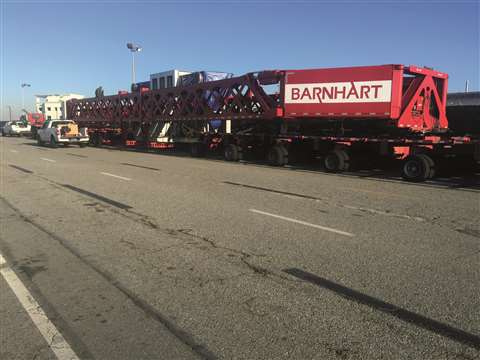
Rigging US$ 750,000 to US$ 2 million: Fagioli
Legendary lift and skid job
Fagioli performed a precision stack and de-stack
In late 2017 and into 2018, Fagioli was called to execute the operation of stacking and de-stacking a 997-tonne gas turbine generator (GTG) module. After the necessary tests executed by the client, Fagioli de-stacked the module in 2018 to ship the two modules separately for their final destination.
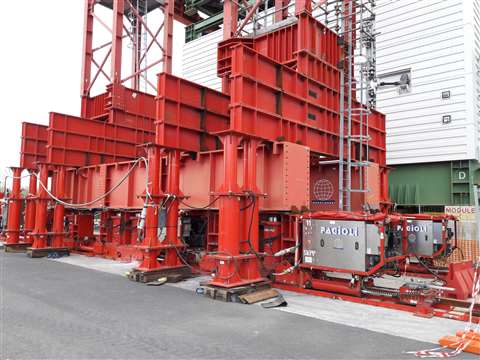
The Fagioli stacking and de-stacking operations were operationally executed in 24 hours for each single activity after a month of ground preparation and equipment assembly
For the execution of the project, Fagioli came up with the idea to lift the module and skid it whilst it was suspended from the tower-lift system. Key equipment utilised included towers, strand jacks, PPU for strand jacks, skid shoes, forklifts, manlifts, a Theodolite and a water-level indicator.
To start the load was taken and lifted – the trussed beams were connected to the upper GTG module. The skid shoes for skidding were positioned and once the inclinometer sensor was installed (and tested) on the module the operation commenced.
“The load was gradually lifted with strand jacks on the lifting towers – with steps of 20 percent of the expected final load, while checking tower verticality, module planarity and skid tracks settlement,” said Fagioli’s president Edoardo Ascione. “Once the strand jack system took the load of the entire module, the skid shoes started moving.”
Checks and rechecks
The load was checked in the skid shoes system according to the expected values until the stroke was 100 mm. Fagioli proceeded with lifting steps by means of strand jacks until the module was lifted 500 mm from the pin guide of the lower GTG module.
Before the first skidding of the upper GTG module began, the vertical stroke was set to around 100 mm. Fagioli operators kept the vertical loads of the main cylinders and horizontal loads of push-pull system under control via computerised systems. While proceeding with the skidding steps, the strand jack loads on each tower were adjusted according to the predefined values by means of strand jacks and skid shoes. The module was then ready for lowering.
The module was then lowered 500 mm from the top of the foundation. At each stroke, load tolerances were checked by computer, and Fagioli operators proceeded with the lowering operation until the module was at the designed elevation. Thus, the module was ready for the second skidding.
Fagioli executed the second skidding with the first stroke of pull-push piston, and proceeded with skidding until the module was in the final longitudinal position on its foundations, and then unloaded.
When the upper GTG module was approximately 200 mm from its foundations, the alignment was verified, and the load was again gradually transferred in steps of 20 percent.
At each load step, Fagioli checked that there was no abnormal deflection on the module structures, on the tower system or no major settlement of the skid tracks.
In total, 15 Fagioli personnel were involved, including five engineers.
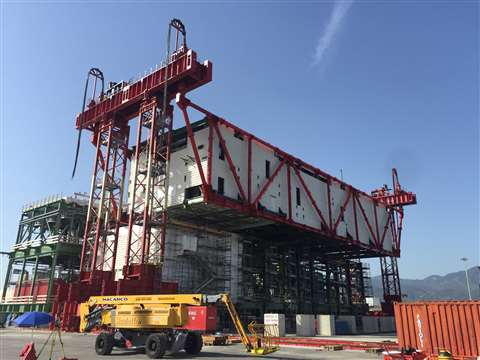
Rigging US$ 150,000 to US$ 750,000: Burkhalter Rigging
Hole in the wall
Burkhalter Rigging extended two railway bridges and a section of Highway 280 as part of a TexRail project
In autumn 2018, Burkhalter was contracted to widen a four-way point of transportation confluence near downtown Fort Worth, Texas, USA. Burkhalter dubbed the project ‘hole in the wall’.
The firm quickly found that widening the formerly single-track-sized hole would require widening Highway 280’s pile cap and pilings as well as widening the rail bridges that run below it. Four rail lines all converge at the hole in the wall, and the highway could only be closed for small periods of time. Burkhalter faced a tight space, and even tighter operative schedules.
Bridge sets a bridge
First, Burkhalter and its client, Archer Western-Herzog, built the new, wider UPRR and BNSF bridges just a few yards away from the site. Each new bridge was fully preassembled on storage beams and stands before being loaded onto Goldhofer SPMT and moved, with the help of Hilman rollers, onto a temporary bridge consisting of Burkhalter runway girders set across the hole.
A temporary mid-span pier was developed by Burkhalter and engineers from Genesis Structures to increase the runway girders’ weight capacity and mitigate a railway path skew of 54 degrees on the tracks above.
Once in place the new bridges were lifted from the SPMT by a J&R hydraulic gantry system. Once the SPMT cleared the area, the runway girders were reverse-launched and the new, wider BNSF Bridge, weighing 605,931 pounds (275 tonnes), was permanently set in place. The same process was repeated in phase three with the new and wider UPRR Bridge. The UPRR Bridge weighed 65,000 pounds (29 tonnes) more.
Phase two of the project was the Highway 280 cap replacement. This involved using a fully automated Enerpac BPU-750 lifting system to lift the active highway bridge weighing 1,334,000 pounds (605 tonnes) approximately one inch during a night closure to facilitate the removal of the existing pile cap, install a longer pile cap to straddle the newly widened area below it and then set the Highway 280 bridge back down onto its supports.
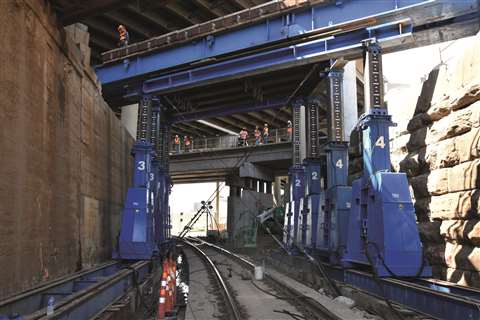
The extremely tight space meant minimal side clearances and small areas for expanding the bridges and lifting Highway 280 for its extension
Rigging under US$ 150,000: Emmert International
On the right track
Emmert jacks and slides two 168,000-pound (76 tonne) thermal heaters across a pre-treatment facility
In October 2018 Emmert International jacked and slid two thermal heaters – each 45 feet (13.71 m) long and weighing 168,010 pounds (76 tonnes) – across a pre-treatment facility in Freeport, Texas, USA.
It was determined that the use of a conventional crane to offload would not be safe or efficient so Emmert opted to employ the use of its 500 tonne Hydra-Slide system.
Emmert constructed a 120 foot (36.5 m) self-propelled track system elevated four feet (1.2 m) above the ground on staging cans and supports that were placed every six feet (1.8 m) along the track to maintain system integrity. The Hydra-Slide system had to be installed to weave the heater through a maze of ground obstacles, as well as overhead process equipment, scaffold structures and pipe racks. At certain points during the slide, the heaters came within inches of nearby pipe racks.
A precise lift
For Emmert, lifting the heaters onto the track proved just as demanding as moving them. Each heater was 45 feet long, 16 feet tall and 18 feet wide (13.71 x 4.87 x 5.48 m). To hoist the heaters onto and off of the slide system, Emmert placed four 100 tonne jacks into jacking cribs on the bottom of each heat exchanger, before lifting them and transferring their weight to hardwood stacked beneath each jack point. The Hydra-Slide track was then cleared from the area by sliding it out from the north end of the staged heat exchanger. Once the track and support cans were removed, Emmert began lowering the heaters into place.
The job took 80 man-hours of planning and 280 man-hours of execution. No safety issues, injuries, damages or other incidents took place during the transport of the thermal heaters.
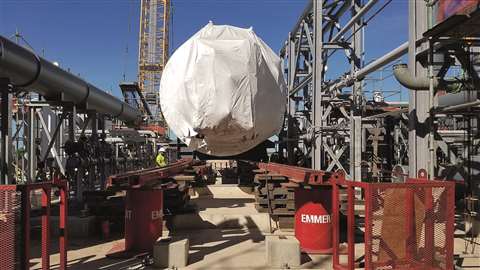
Emmert used a Hydra-Slide system to manoeuvre the thermal heaters
Moving with specialized equipment: Fagioli
Tailor-made transport
Fagioli transported and loaded 42 jacket modules with a custom jacket system transport structure in Spain
Fagioli was contracted for the weighing, transport and load out operations of 42 jacket modules, weighing up to 950 tonnes in Spain from the manufacturing area to load out quay. Of the five types of jacket, the larger models were 66 metres tall, 32.6 m long and 25.9 m wide.
“We had to take into consideration how to speed up the load out operations in a safe manner, considering the dimensions and weight of the modules and the 11 barge voyages that were planned for the sea transport,” said Edoardo Ascione, Fagioli Americas president and managing director. “In addition, we had to factor in how to avoid delays due to wind and bad weather conditions, and execute the load out activity onto a barge to take the load of four jackets positioned in a row.”
The team decided to use self propelled modular transporter divided in two rows for the transport of each single jacket. On top of this configuration, Fagioli fabricated a tailor-made frame. The structure was composed of two transport beams, eight capping beams, 16 guy journals, eight tower sections, four beams, two additional structures, two base frames, spreader mats and spreader beams. Jackets were then transported from the fabrication area to the temporary storage area, and then loaded onto the barges. During the jacket site transport, the load was imposed through the SMPTs spine beams, and applied as an equally distributed load.
Flexible handling
A key challenge was to create a frame structure which was able to lift the jackets and execute the loadout operations. Fagioli found the solution with a retractable edge main beams with moveable stoppers, positioned nine metres above ground. This allowed flexibility in handling the configurations of the jacket modules. The SPMT then took the load with the frame structure and lifted the jackets.
After executing the weighing operations using load cells, Fagioli moved the jackets to the storage area using the frame system. The jackets were then provided with an upper grillage for the sea transport. After this operation a 128-metre barge was waiting for the load of four jackets.
The tailor-made structure reduced dimensions compared to those used in the past for kind of jacket. The reduction in width dimension allowed modules to be loaded and positioned onto the barge at the same time that the SMPT with frame structure were able to come back to take the modules.
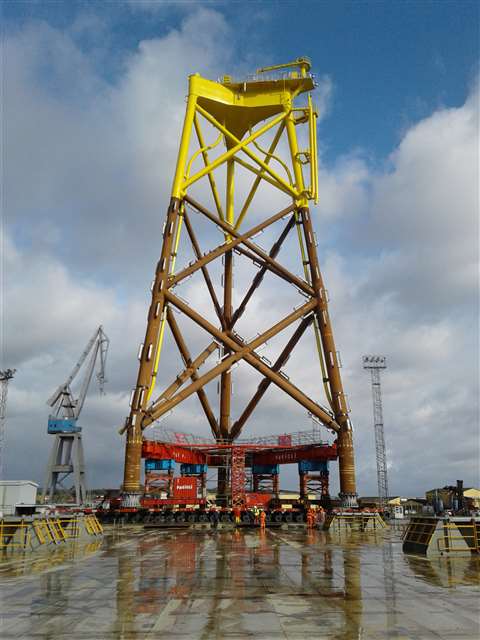
Trucking over 500,000 pounds (226796 kg): Barnhart
Uncharted territory
Barnhart transported three slug catcher vessels across the Continental Divide in the USA
Barnhart was tasked with hauling three huge slug catcher vessels from Pocatello, Idaho to natural gas facilities in Fort Lupton, Colorado and Hereford, Colorado. The job was awarded in April 2018 with a delivery date of “no later than Thanksgiving Day,” seven months later.
The first task for Barnhart’s Long Beach, California-based engineering team was to develop a trailer configuration. Due to Colorado regulations, axle weights had to be at or below 42,400 pounds (19 tonnes) per line.
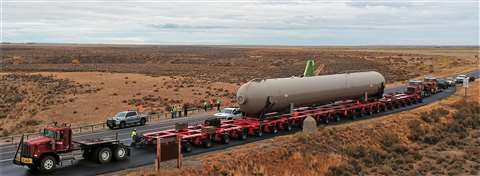
Working with Goldhofer engineers, a system of Goldhofer THP/CA dual lane trailers with self-tracking bolsters was configured. Because the permanent saddles on the vessels did not allow for enough axle lines, Barnhart custom designed transport saddles, added more securement points to the bolsters, and fabricated four compression securement struts. The compression struts secured the permanent saddles on the vessel to the transport saddles on the bolsters to meet securement requirements.
The trailer configuration and securement plan were accepted in May. The next step was creating a viable route through Idaho, Wyoming and Colorado. De-rated bridges in Wyoming and highway construction in Colorado were obvious obstacles. A third-party bridge engineering firm evaluated every structure on the route. Barnhart created three routes through Wyoming and chose the one with the least de-rated bridges, which numbered four. In Colorado, the best route was through a construction zone where a new roundabout was being constructed.
Transportation challenges
In September, the trailer system was built alongside the first vessel in the customer’s crane bay. Using two overhead cranes, the vessel was lifted, side shifted and placed onto the trailer and secured.
Pulling out of the plant in Pocatello, the first challenge was a 90 degree left hand turn. The team made it to the Wyoming state line in two nights. At this point they could travel during the day, but 4 to 8 percent mountain grades, a snowstorm, and the four bridge crossings slowed travel.
The first bridge was bypassed with a roadway road detour. The second bridge required a crab manoeuvre by travelling the front trailer section in the eastbound lanes and the rear trailer travels in the westbound lanes. For the third bridge, eight wing dollies with custom-built mounting brackets were added to the THP/CA trailers. The fourth bridge was actually a culvert that Barnhart used its 60 foot (18 m) long bridge jumpers to cross.
The first leg of the Colorado route was performed at night to get through the construction zone. The second leg was in the daytime due to lack of utility support. A hard left turn in Fort Collins was executed in one shot for each vessel. Police and highway patrols in all three states escorted the load, in addition to utility trucks and Barnhart’s safety and bucket truck crews.
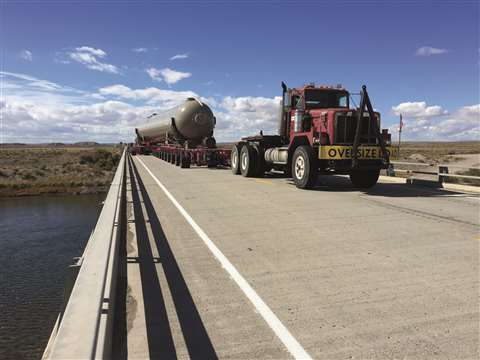
Bridges along the route posed a variety of challenges
Trucking 160,000 to 500,000 pounds (73 to 227 tonnes): Fagioli
Narrow navigation
Fagioli moved two rotors via road to a power plant in the mountains of Italy
Fagioli was commissioned for the transport of two rotors weighing 170 tons (154 tonnes) each from Genova up to Premadio in Italy. The route went through through mountainous roads and villages and was completed over nine nights in 2018.
The rotors were loaded and secured onto Fagioli’s transport system that included 2 by 11 axle lines rigged with 180 tonne girder beams. The convoy length was close to 61 metres, and the trip would span 450 kilometres.
“Fagioli was in strict contact with all local authorities of three Italian regions in order to be as quick as possible to execute the installation of over bridge structures, and to find the right places to rest the long convoy avoiding traffic movement,” said Edoardo Ascione, president and managing director, Fagioli Americas.
During the fourth and fifth nights, Fagioli executed the installation of two over bridge structures, at 17.7 m each, to pass two bridges with low capacity. Arriving in Lecco, it was necessary to use six axle lines of SPMT provided with 2 by 5 m towers to reinforce a ring road bridge. The trip became more challenging as the convoy passed through small towns, roundabouts and tackled 33 km of hills and bends.
The team also had to reconfigure reinforcement structures under a bridge in Morbegno, after the length of the structure didn’t allow safe passage. Fagioli executed the transport with a 20 metre long over bridge structure. In Bormio, the convoy was reduced with the support of two mobile cranes which lifted the rotors and positioned them onto a 12 axle line modular trailer.
On the final night, Fagioli completed the last three kilometres of their journey. Once outside the power plant, it used a gantry lifting system to modify the configuration of the convoy for the third time to accommodate the steep slope. The convoy entered the 500 metre tunnel supported by the use of two trucks at the back.
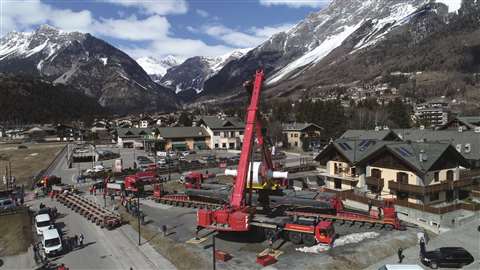
Trucking under 160,000 pounds: Omega Morgan
Problem solving
A 39-mile (63 km) route posed a series of challenges for Omega Morgan
Omega Morgan transported three ozone contact tanks from a Newberg, Oregon, USA, fabricator to a water treatment facility in Hillsboro, Oregon. The project was secured on 11 May 2018 and finished less than two months later.
The vessels were loaded onto Omega Morgan’s perimeter deck trailers using overhead cranes.
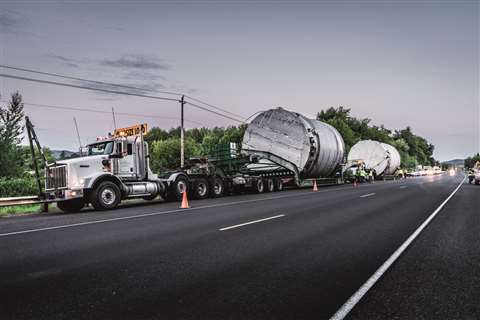
Omega Morgan’s innovation centered on solving extreme route challenges, keeping the tight schedule and not modifying or damaging the ozone tanks
One of the biggest challenges was determining and executing the route. “We had to find a route that could accommodate two loads at the same time with the least amount of utility work required so we could meet our customers deadline of less than 30 days from time of notice to proceed,” said project manager Erik Zander. “We accomplished this by assigning two project managers along with one permit tech, one engineer and two superintendents in the initial planning.”
Safety considerations
Two big safety considerations were utility work and traffic congestion during the two-night journey. A huge number of wires needed to be lifted and removed. Typically, Omega Morgan hires a company that is certified to move power to handle the high and low voltage conflicts. But the local power companies didn’t want a subcontractor to handle the work, so Omega Morgan hired individual companies along the route to move their associated conflicts. This was challenging, it explained, because five to eight utility trucks had to travel with the convoy and manoeuvre around it on the narrow, two lane roads. With the short window for planning, identifying and securing the services of the utility companies was complex.
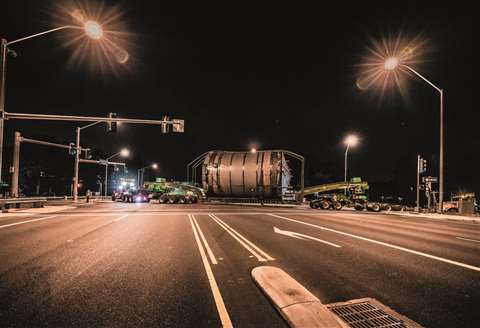
There were more than 20 vehicles in the convoy at any given time
Including pilot cars, traffic control and the utility vehicles there more than 20 vehicles in the convoy at any given time. Finding safe locations to clear traffic and move around support vehicles was a constant concern.
In some places there wasn’t space to set up the bucket trucks to lift the lines. They had to be placed in fields to make their lifts.
The key to expediting this move was to keep the overall travel height as low as possible, Zander said.
“After our review of the tanks our engineering team realised if the vessel was rotated 6 degrees the overall ride height could be lowered by 4 inches,” Zander said. “We utilised some low-pro four-inch carriers as well. Omega Morgan also built custom saddles that accommodated the nozzles on the vessel to save even more height.”
With safety being a constant concern, the superintendent acted as the safety officer for the three hauls. There were daily crew safety meetings, constant over-route communication with the Department of Transport and utility companies.
Prior to arriving to the treatment facility Omega Morgan team had to transload the vessels using its Scheuerle Kamag K25 platform trailers to place them within reach of cranes for final placement.
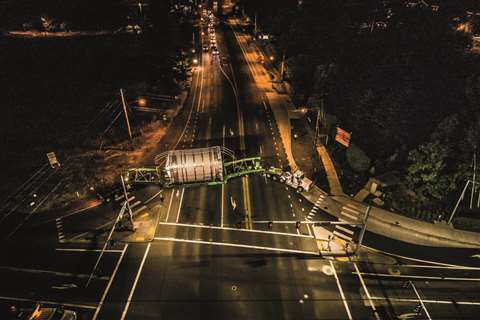
Potential traffic congestion was a safety consideration during the journey






